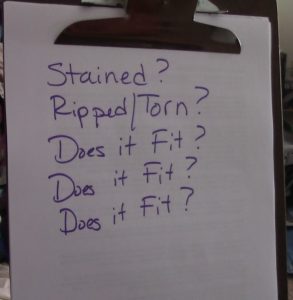 Clothing, style, and how we look can be intimately tied to our identity. It can serve as an armor that makes us feel safe or simply something that makes us feel good or beautiful, handsome or happy. Other clothes in our closets may remind of specific events, like concerts or summer camp or a vacation we took. There are also items that remind us of different times of our life or individuals who influenced us. This can be especially evocative when the people associated with certain clothes are no longer in our lives.
Clothing, style, and how we look can be intimately tied to our identity. It can serve as an armor that makes us feel safe or simply something that makes us feel good or beautiful, handsome or happy. Other clothes in our closets may remind of specific events, like concerts or summer camp or a vacation we took. There are also items that remind us of different times of our life or individuals who influenced us. This can be especially evocative when the people associated with certain clothes are no longer in our lives.
Purging our wardrobes to keep only those clothes that we actually wear on a regular basis flies in the face of these ideas. Letting go of pieces of clothing can feel like letting go of pieces of our self, our past, our loved ones. Yet, for a de-cluttering or other reducing project, we have to find a way to make peace with that idea.
Re-Thinking Your Wardrobe
I spent years retraining my brain to see clothing as just clothing. The memories I associate with items are not connected to the item. If I let go of a t-shirt from camp, I am not losing any of the memories of camp. The same applies to clothing that is associated with a specific person. That sweater that your grandmother made you is not your actual grandmother and all the memories you have will remain even if you donate or recycle the sweater.
If you are having trouble letting go of a specific item or items, consider keeping a part of it. Take a photo of yourself wearing it so that you still have a trigger for the memories. If an item is old and worn out, consider cutting out a scrap of it to keep in a memory bag or box. Just enough to remind you of how soft and fuzzy it was or the logo that reminds you of the event, etc. If you have any sewing skills, you could make a patchwork of these scraps to create a pillow or quilt. If you’re not sewing-inclined, there are companies that will make quilts out of old t-shirts, prominently displaying the logos from concerts, schools, sports, etc.
The World is Your Closet
 Embracing the idea that you are not your clothes is a good first step. Another step is to rethink why you acquire clothes. Do you buy a suit or dress for one occasion and then hold onto it because you *might* need it again in the future? Do you stockpile things that are on sale, like underwear or socks, so that you’ll have them “when” you need them? Ask yourself: does your wardrobe need to cover every potential clothing need you’ll ever have?
Embracing the idea that you are not your clothes is a good first step. Another step is to rethink why you acquire clothes. Do you buy a suit or dress for one occasion and then hold onto it because you *might* need it again in the future? Do you stockpile things that are on sale, like underwear or socks, so that you’ll have them “when” you need them? Ask yourself: does your wardrobe need to cover every potential clothing need you’ll ever have?
This is the 21st century. Clothing stores, department stores, thrift and consignment stores are everywhere. The odds are that if you need a fancy dress or a suit or new socks, you can go out and buy them when you actually need them. When we’re living on the road with limited closet space, we won’t be able to store a huge wardrobe for every occasion. When we need an outfit for an interview or gallery opening or whatever, we will be able to find something within a day or two. If it’s something we feel like we’ll wear on a regular basis, we can keep it. However, if it’s a one-time wear, we can resell it or donate it so that it 1) is out of our closet and 2) can find its way into someone else’s closet – someone who will use it more than we would. Reminding ourselves that the world is our closet helped us let go of many seasonal and specialty items in our wardrobes.
Go Slow, If You Can
If you’re looking to de-clutter your closet just a little, you won’t need to do a major sort. Now that you’ve re-thought your clothing needs, take a few minutes once a day to remove just one or two items. By the end of a week you’ll have made a good start at reducing your wardrobe.
There are a few other options you might want to consider to help you see what clothes are actually essential in your wardrobe versus the stuff that’s just taking up space. The first is the hangar test. Simply turn all the clothes in your closet around so that the hangars are backward. Then when you wear something, put it back the right way. After a month or a season or some other period of time, remove any clothes that are still on backwards hangars. You’ll want to take into account things like seasonality, but it’s a good way to see what clothes you are actually wearing on a regular basis.
You may have heard of the 333 Project, which is another way to reduce your wardrobe. The idea is that for three months you operate with a wardrobe of 33 items (or less, if you can). Those 33 items include clothing and accessories like shoes and jewelry. There are some exceptions for things like wedding rings and uniforms. Box up and store all your other clothing for the three months. If you absolutely have to take something out of the boxes, you’ll need to pull something from the 33 items and put it in the box. At the end of three months assess how you did. Maybe you’ll want to go on another three months to see what you wear once the seasons change. Eventually, you’ll be able to sell, donate, or recycle those items that never make it into your 33 items. Details on Project 333 can be found here.
When You Have to Radically Reduce Your Clothes
Downsizing or simply moving can be a great motivator for reducing your wardrobe all at once. We’re going from a large house to an RV, so space will be at a premium. Our approach? Literally pile all our clothing on the floor and sort through it by asking five simple questions (see below). If it didn’t pass all five, it was gone. Now, we made sure to sort our clothing separately, because sorting another person’s stuff can cause all sorts of problems in any type of relationship. However, when we each did our sort, the other person was sitting nearby to provide moral support and encouragement. Those sentimental attachments can be strong in clothes, so even if you’re single, consider having a trusted friend or family member sit with you during your sorting session.
 The five questions we asked about each piece of clothing?
The five questions we asked about each piece of clothing?
- Is it stained? – If yes, it’s designated for re-purpose/recycle.
- Is it torn/ripped? – Re-purpose/recycle.
- Does it fit? – If it’s the wrong size/shape for your body, it goes.
- Does it fit? – If your personal style has changed, don’t hold on to items from a previous style.
- Does it fit? – Only keep the clothes that fit in your closet/dresser with some breathing room for the fabrics.
It is hard to realize how often we hold onto to things that no longer fit in our life. We may have changed sizes or evolved our personal style but still cling to clothes that were more suited to our past self than who we are now. We fill the closets in the spare rooms and load up tubs that get shoved in the garage or basement or even rent a storage unit to hold the overflow, but how often do we actually wear clothes that aren’t in immediate reach? Make sure that the clothes you have fit you, your style, and your space.
A word about “old clothes.” Most of us have a stash of old, comfortable clothes that may be stained, ripped, and threadbare. We keep them for those “no pants” days when we don’t leave the house or pull them out when we need to do a messy job like fixing the car or doing spring cleaning. In our case, we both have “painting clothes” for when we head to the studio to make art, because art is messy. We allowed ourselves to keep a few sets of such clothing so that we have them on hand, but only a few. No one needs a dozen ripped and stained shirts – unless they are costuming a play.
Saying Goodbye to Your Clothes
Sorting through your clothes is only half the battle. Next you have to dispose of them. We recommend doing it as quickly as possible after sorting, so that you don’t have time to second-guess yourself. Once you’ve made your choices, stick to them.
The specific options you have for disposing of used clothing will vary based on your location as not all programs are available everywhere. Do a little bit of research and you’ll likely find a variety of places in your area that fit each of the following categories:
- Resale/consignment shops
- Online sellers like Craigslist and eBay
- Garage/Yard sale
- Charitable thrift stores
- Charity clothing drives (annual or seasonal rather than ongoing)
- Homeless shelters
- Domestic violence shelters
- Refugee support organizations
- Interview/Workplace attire programs
- Winter coat drives
- Quilter/sewing circles
- Art programs looking for cleaning rags
- Recycling programs (turn old clothes into blankets, industrial rags, etc.)
Lastly, you’ll have to deal with the hangars. Some dry cleaners will recycle wire hangers and it’s possible that some city recycling programs will accept certain plastics, but again, you’ll need to do your research. If anyone has ideas on what to do with hangars, please share them with us in the comments or on social media using #RadicallyReducing.
We managed to reduce our combined wardrobe by over 100 items during our sort. Let us know how you did when you de-cluttered your closet.